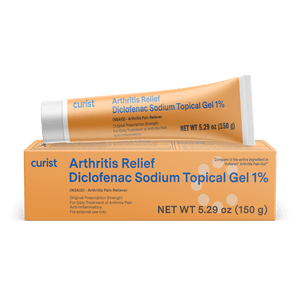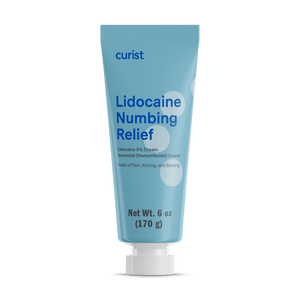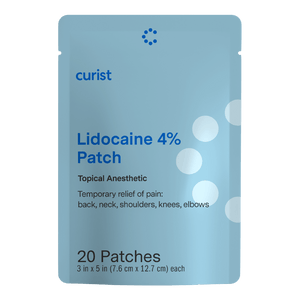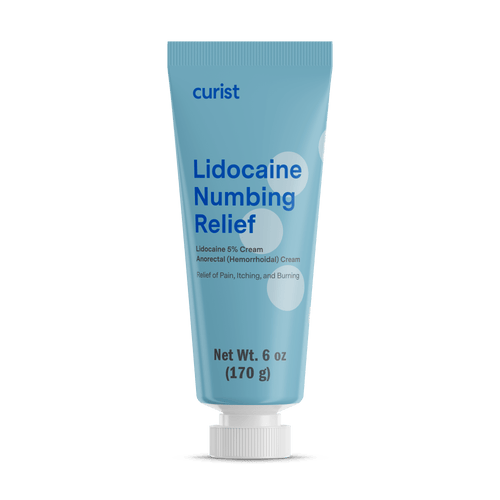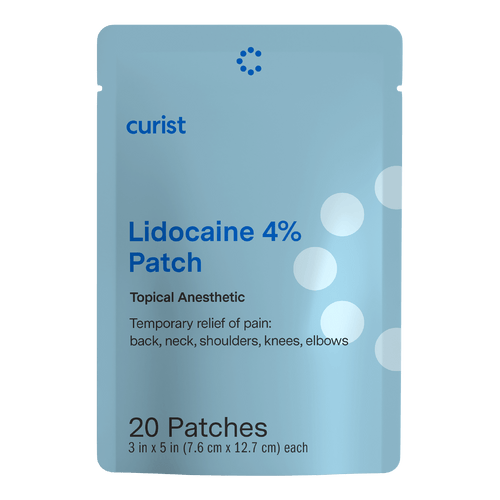Curist delivers over-the-counter medicines to your door at a fraction of the price of traditional brands. We hope everyone stays safe and healthy during this time.
When it comes to topical treatments for pain relief, diclofenac gel and lidocaine cream are popular options. Have you ever wondered what the differences are between the two?
Is Diclofenac the Same Thing as Lidocaine?
Diclofenac and lidocaine are not the same thing; they are two different medications. Diclofenac and lidocaine both relieve pain, but do so via different mechanisms and are used for different conditions. Diclofenac gel was formulated for arthritis-related joint pain and lidocaine cream is commonly used to numb pain.
How do Diclofenac Gel and Lidocaine Cream Work?
Diclofenac is a nonsteroidal anti-inflammatory drug (NSAID), which works by inhibiting enzymes that lead to the production of important inflammatory mediators (i.e., prostaglandins and thromboxanes). Blocking this response ultimately results in reduced inflammation, pain, fever, and swelling.
Lidocaine is an anesthetic that numbs pain by blocking nerve conduction and interrupting the transmission of pain signals. Depending on the strength lidocaine can be useful in treating backaches, muscle soreness, mild joint pain, itching, and irritation. Please note that lidocaine at the 5% strength should only be used for anorectal or hemorrhoidal use, while lidocaine at the 4% strength can be used for topical use on the body.
How are Diclofenac Gel and Lidocaine Cream Similar?
Diclofenac gel and lidocaine cream are both topical treatments that provide direct pain relief to the site of application. Neither diclofenac gel nor lidocaine cream should be applied on skin that is broken, infected, swollen, or covered with rash. Topical pain products may be preferred treatments especially for patients who are unable to swallow pills or have other medical conditions that require more caution around systemic side effects. Although diclofenac gel and lidocaine cream are often used for different conditions, both products may be used to manage joint pain. Please note that lidocaine at the 5% strength should only be used for anorectal or hemorrhoidal use, while lidocaine at the 4% strength can be used for topical use on the body.
What are the Key Differences between Diclofenac Gel and Lidocaine Cream?
Depending on the strength, lidocaine can be used to treat backaches, muscle soreness, mild joint pain, itching, hemorrhoid irritation, and nerve pain. Generally, lidocaine cream takes around 30-60 minutes to start working and may last for 1-3 hours, depending on how long the cream stays on the skin. Please note that lidocaine at the 5% strength should only be used for anorectal or hemorrhoidal use, while lidocaine at the 4% strength can also be used for topical use on the body.
In contrast to lidocaine cream, diclofenac gel is most effective at treating arthritis-related joint pain. The full effects of diclofenac gel are typically felt within 7 days of applying four times daily (although it is possible to feel some relief after a few hours), and may last for 1-2 days after final application. In addition, diclofenac gel should only be used on the hands, wrists, elbows, knees, ankles, and feet. It is not recommended for use in other areas with pain deeper below the surface of the skin, such as the back, hip, or shoulder.
Is Diclofenac Gel Stronger than Lidocaine Cream? Is Lidocaine Cream Stronger than Diclofenac Gel?
The effectiveness and strength of diclofenac gel vs. lidocaine cream will depend on the type of pain and the affected site. Diclofenac gel is most effective for arthritis-related joint pain, while lidocaine (depending on the strength) is most effective for burning, itching, irritation from hemorrhoids and anorectal conditions, and nerve pain. Please note that lidocaine at the 5% strength should only be used for anorectal or hemorrhoidal use, while lidocaine at the 4% strength can be used for topical use on the body.
In terms of side effects, both may lead to irritation at the site of application. However, caution is advised when using NSAIDs such as diclofenac if you have cardiovascular disease, kidney or liver impairment, aspirin-sensitive asthma, or a history of ulcer disease or gastrointestinal bleeding. It is important to discuss pain relief options with your doctor before using this medication.
What is Better for Arthritis Pain: Diclofenac Gel or Lidocaine Cream?
Broadly speaking, diclofenac gel is a better option for treating arthritis pain than lidocaine cream. NSAIDs are analgesic (pain-relieving) and anti-inflammatory agents that have shown great efficacy in arthritis. Diclofenac gel is a topical NSAID that exhibits comparable effectiveness with a lower risk of systemic side effects when compared with oral therapy. This makes diclofenac gel a recommended first-line option for arthritis-related joint pain per the American College of Rheumatology (ACR) OA Treatment Guidelines. It should be noted that diclofenac gel is only recommended for application to the hands, wrists, elbows, knees, ankles, and feet.
Insufficient data exists to recommend lidocaine specifically for arthritis, and lidocaine is not indicated for the treatment of arthritis.
What is Better for Hemorrhoids: Diclofenac Gel or Lidocaine Cream?
Lidocaine cream is better for pain and irritation caused by hemorrhoids and other anorectal disorders. Lidocaine works to numb pain by blocking nerve conduction and interrupting the transmission of pain signals. It is important to note that lidocaine cream should not be applied inside the rectum, and should be discontinued if you have rectal bleeding. Lidocaine cream should not be applied on skin that is broken, infected, swollen, or covered with rash. Discuss pain relief options with your doctor if your symptoms persist.
What is Better for Nerve Pain: Diclofenac Gel or Lidocaine Cream?
When used under the care of a doctor, lidocaine cream can be better than diclofenac gel for nerve pain. Lidocaine is an anesthetic, and numbs pain by blocking nerve conduction. Lidocaine cream should not be applied on skin that is broken, infected, swollen, or covered with rash. Discuss pain relief options with your doctor if your symptoms persist. Please note that lidocaine at the 5% strength should only be used for anorectal or hemorrhoidal use, and should not be used for general nerve pain.
Can I Switch from Lidocaine Cream to Diclofenac Gel?
If you have arthritis-related joint pain that is not relieved by lidocaine cream, diclofenac gel may be a great option to consider. However, it is recommended that you speak with your doctor before making changes to your pain regimen. Diclofenac is an NSAID, which may require extra precautions depending on your current medications and other health conditions/history.
Can I Use Diclofenac Gel and Lidocaine Cream Together?
There are cases where using a topical diclofenac gel together with lidocaine cream may be effective in managing pain, but this must be done under the supervision of a doctor. Discuss pain relief options like the use of lidocaine cream and diclofenac gel with your doctor before using these medications together.
Where Can I Buy Diclofenac Gel and Lidocaine Cream Online?
Diclofenac gel and lidocaine cream are available in local pharmacies as well as stores online like Curist, and do not need a prescription.
At Curist, we develop FDA-approved equivalents to big brands in order to provide the same medicine relief but at half the price of the brands. Curist products are sold online and shipped directly to your door. Curist carries:




